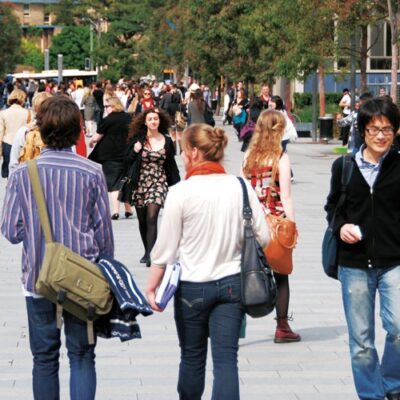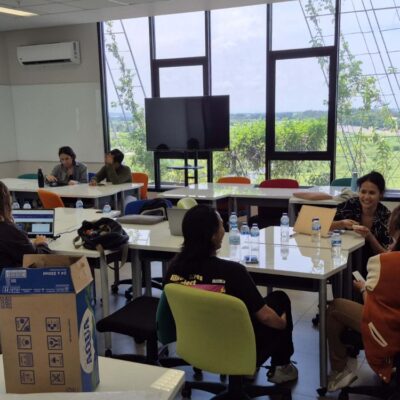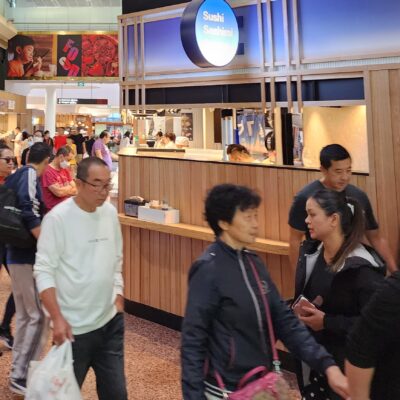This article critically examines how digital communication technologies impact the ways older Filipina Australian women provide care to their family members and peers in Australia and in the Philippines. In recent years, smartphones, social media, and mobile applications have become ubiquitous and are changing the way care is delivered by ageing Filipina Australians to nuclear and extended family members mainly by facilitating communication. While this can have advantages it can also be a burden.
In March 2023, I conducted fieldwork in Victoria (Australia’s second most populous state) as part of a research project designed to examine the care practices of older Filipina Australians. Deploying in-depth interviews and visual methods, I engaged 15 ageing Filipina Australians to share their experiences of using digital devices and online channels as part of the everyday care practices. They also shared content stored in their devices to further reflect on the rationale and impacts of digital media use in their care practices. In this piece, I highlight the story of Lisa (not her real name), whom I interviewed in Geelong, a regional city of the state of Victoria, to illustrate the ways Filipino Australian women perform care through digital media use in their later years.
Lisa, who is in her 60s, moved to Australia in 1985 along with her son from a previous relationship to join her Australian partner who she met via exchanges of letters on penpal (a website where users can meet people and write to them). Sadly, her son died in 1990 and her marriage fell apart. In 1997, she met another Australian in a factory where she was working. They married and have been together for 25 years.
At the time of our interview, Lisa and her husband were preparing to attend the wedding of her youngest brother. However, the trip would be expensive and since retiring a year before, she and her husband had been reliant on a pension. Lisa worked for many years in a carpet factory, and her salary supported herself and her husband who also worked in a factory. During the interview, Lisa expressed that she felt stressed about the extra expenses such as helping pay for the travel expenses of other family members to attend the wedding and presents for family, such as two balikbayan boxes (large boxes containing items sent by overseas Filipinos) filled with ‘pasalubong’ (souvenirs). Lisa felt obliged to provide this financial and other support.
As the only family member based overseas, Lisa revealed that she has been been regularly providing financial support for the education of some of her nephews and nieces. She also supports a charity in the Philippines which helps poor children attend school. To provide these caregiving practices, she uses her smartphone and messaging applications to communicate regularly, generate information, assess her family members’ needs, and send money.
Filipino migration to Australia
Lisa is one of the many migrant Filipinos spread across the world who perform and deliver continuous caregiving to their family and community members in the Philippines as well as in their new nations.
Filipino migration to Australia has occurred in three broad waves. In the 1800s, the arrival of Filipinos who were employed in the pearling industry marked the first wave. In the 1900s, the second wave reflected the flows of Filipino migrants who were mostly spouses of Australian residents, such as Lisa. It was also during this period when family members of Filipino migrants often moved to Australia. The most recent third wave is characterised by the influx of professional and skilled migrants informed by the labour demands of various sectors in Australia.
Filipino Australians are the fifth largest migrant community in Australia. At the most recent Census in 2021, there were 293,892 Philippine-born people in Australia. Most were female (61.5 percent ) and 38.5 were male; and the majority were Australian citizens (61.5 percent). In Australia, permanent residents and citizens such as Lisa are provided with access to social welfare systems and benefits, such as Medicare and a pension.
The migration of Filipinos to many parts of the world is rooted in the long history of economic and political instability in the Philippines. In 1974 then President Ferdinand Marcos issued Presidential Decree 422, promoting migration to address poverty, under-employment and unemployment. The Labor Code of 1974 formalised a Philippine labour migration program underscoring the benefits of overseas contract work. The supposedly temporary solution became a permanent mechanism to redress the nation’s economic problems. Additionally, the exportation of human labour has become a means for the Philippine state to earn income via remittances received from Filipino migrants and repay loans from the International Monetary Fund (IMF) and World Bank. To date, the Philippines is one of the major sources of labour migrants across the world.
The Philippine government remains dependent on remittances. Currently, there are approximately 1.83 million Overseas Filipino Workers. These individuals are relied upon by their family members back home who experience unstable economic conditions. In Philippine culture, the tradition of giving especially among migrants to their nuclear and extended family members in the Philippines is a sign of love, respect, and care. Notably, the constant support of overseas Filipinos to their family is encouraged by the Philippine government as being self-sacrificing and caring. As a recent report shows, cash remittances from overseas Filipinos reached USD 12.98 billion in May 2023. This huge contribution and sacrifice of Filipinos overseas has resulted in the Philippine government labelling them ‘bagong bayani’ (modern-day heroes).
Gender inequities in and beyond the household
Philippine migration is highly feminised. There were 1.10 million women Overseas Filipino Workers in 2021 (60.2 percent). They work in a range of jobs across industries, but a stereotypical gender division of labour usually occurs, with women mostly working as caregivers, nurses and domestic workers as well as in service and sales positions. Meanwhile, men typically work as electrical and electronics equipment assemblers, drivers, ship deck crews, and in related trades. The concentration of Filipino women and men in these jobs indicates the gendered norms ascribed to Filipino migrant workers.
In Philippine society, mothers are expected to be the primary carers, while fathers are expected to be the primary income earners. This division of household responsibilities remains largely unchanged, despite the growing number of women involved in paid work to financially support themselves and their family members. This arrangement reflects ‘double work’ or ‘double shift’ for women.
Filipino women, despite living overseas, do not escape the gendered discourse, norms, and division of caregiving labour in the household. In their later years, Filipinas continue to work and send financial support to their children, grandchildren and relatives back home. This is also the case for older Filipina Australians, such as Lisa.
The gendered, familial, and moral obligations of Filipina migrants create a caregiving burden. Those who are in a precarious financial situation experience financial stress. For instance, in the case of overseas older Filipinas, the struggle to accumulate retirement funds in low paid and insecure work is aggravated by the pressure to send money and cover the everyday needs of their family back home. In Lisa’s situation, the pension is split across her needs and her extended family members in the Philippines.
Lisa’s digital world
Lisa uses a smartphone, social media, and messaging applications to stay connected with her family members and relatives in the Philippines. She did not have a child with her current Australian partner, but as part of an extended Filipino family, she performs the role of a sister to her siblings back home, a mother to most of her nephews and nieces in the Philippines, and a grandmother to the children of her nephew in Australia. She communicates with her siblings overseas. She regularly contacts her nephew and his family in Victoria to visit her house for a gathering during weekends. She sends money to support the education of her nephews and nieces. Given her role in her extended family, she’s called ‘Nanay’ (Mother) by some of her nephews and nieces.
She checks Facebook notifications daily. She responds to comments on photos posted by her friends in Geelong. She also uses Facebook to post photos of flowers in her garden, her cooking, and outdoor activities. Her reason for posting is that: ‘I feel good about it, and I share it. I share it to them (her networks) so they can see something. I don’t do much at home [because of her free time due to retirement). At least, this [referring to posting photos and showing activities) makes them see I am doing something.’ Her family members sometimes comment, giving her a warm feeling of being remembered. Lisa also often participates in video calls, allowing her to interact synchronously with her distant networks while she’s doing household tasks. Through online interactions, she is updated with the activities of her extended family members back home and she feels a sense of imagined co-presence with them. For Lisa, the interactions are mostly a source of happiness.

A photo of Lisa’s garden posted on her Facebook page. Credit: Lisa
However, Lisa also sometimes feels frustrated especially when connecting overseas reveals ‘bad news’. While video calling with her distant relatives, she learnt that her property in the Philippines—a ‘bahay kubo’ (nipa hut)—was destroyed by a typhoon and required major reconstruction. At the time of the interview, she was hesitant to have it rebuilt because of the cost of maintaining it on top of paying the caretaker and her other financial obligations already mentioned.
The paradox of caregiving via digital media
The advent of modern communication technologies has reconfigured caregiving among Filipina migrants. In Lisa’s case and many others, delivering care to her family members in the Philippines has been facilitated by using a smartphone and social media. Out of a total population of approximately 114 million in the Philippines, there are 85.16 million internet users and 84.45 million social media users. This has advantages and disadvantages, as outlined in my book ‘(Im)mobile Homes: Family Life at a Distance in the Age of Mobile Media.’
Through digital communication technologies, Lisa cares altruistically for her extended family, as reflected in her sacrifices to provide financial support even though she has limited financial resources. As she explained ‘I help them to improve their lives.’ This is reflected in her nephews and nieces finishing their studies as well as thanking her. When asked how she feels about her ongoing support to her nephews and nieces, she stated, ‘I don’t ask for anything in return. As long as they say, hello, or thank you. They say, ‘Thank you, Auntie’.’
But it is important to not lose sight of the invisible caregiving burden experienced by ageing Filipina Australians such as Lisa. Limited economic resources, often accumulated through many years of sacrifice, hard work, and sometimes precarious employment, are distributed, and can be depleted through everyday acts of performing gendered roles and familial duties. This begs the question, what will be left for older Filipina Australians to care for themselves?
Conclusion
Digital technologies and online channels are integral to the ways older Filipina Australians perform care and maintain connections. However, these technological tools also reinforce and compound gendered and familial responsibilities. For ageing Filipina Australians, everyday digital media use enables them to enact multiple roles, such as a caring wife, a filial sibling, or loving mother and grandmother. However, behind the fulfilment of these obligations lies financial stress. Ageing women Filipina Australians bear the burden numerous caring roles and limited financial resources. Thus far, several initiatives in the Philippines have already been implemented to advocate for gender equality and empowerment. In Australia, special attention is needed on intersectional approaches to better support the lives of older women from migrant backgrounds, such as protecting them from abuse and violence in domestic spaces. In so doing, a range of culturally tailored and gender sensitive interventions can enhance the capacities of older migrants in navigating increasingly transnational and digital households.
The data used in this piece is based on the project funded by the University of the Philippines Centre for Women’s and Gender Studies.
Main image credit: Bibhash Banerjee/Pexels.




